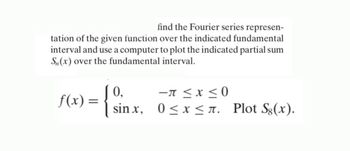
Elements Of Electromagnetics
7th Edition
ISBN: 9780190698614
Author: Sadiku, Matthew N. O.
Publisher: Oxford University Press
expand_more
expand_more
format_list_bulleted
Question

Transcribed Image Text:find the Fourier series represen-
tation of the given function over the indicated fundamental
interval and use a computer to plot the indicated partial sum
Sn(x) over the fundamental interval.
f(x) = {
0,
sinx, 0≤x≤л. Plot Sε(x).
Expert Solution
This question has been solved!
Explore an expertly crafted, step-by-step solution for a thorough understanding of key concepts.
Step by stepSolved in 2 steps with 5 images

Knowledge Booster
Similar questions
- 3. Use the second method of frame assignment, and find the Jacobian of the following robot using the velocity propagation method (Ignore all theta related offsets): 03 02 L2 01 Please answer the question precisely and completely to use the second method of frame assignment to find the D-H table [alpha (i-1) , a (i-1) , d (i) , theta (i)], and find the jacobian matrix using the velocity propagation methodarrow_forwardSolve the inverse kinematic problem for the following 6 DOF robot, using the method ofkinematic decouplingif it is known that its Denavit-Hartenberg parameters are as shown in the table inthe tablearrow_forwardFind the local maximum and minimum values and saddle point(s) of the function. You are encouraged to use a calculator or computer to graph the function with a domain and viewpoint that reveals all the important aspects of the function. (Enter your answers as comma-separated lists. If an answer does not exist, enter DNE.) f(x, y) = 9 sin(x) sin(y), −? < x < ?, −? < y < ? local maximum value(s) local minimum value(s) saddle point(s) (x, y) =arrow_forward
- Please solve the following by hand and without the use of AI. I am working to understand the step by step procedure of solving this problem so pleaase give a detailed step by step procedure, explaining each part as you go. Thank you!arrow_forwardFigure 3 shows the numerical solution of the advection equation for a scalar u along x at three consecutive timesteps. 1.0- 0.8- 0.6- 0.4- 0.2 0.0- -0.2- -0.4- -0.6 T T T 3.0 3.5 4.0 4.5 5.0 5.5 6.0 6.5 Figure 3: Advection equation, solution for three different timesteps. a) Provide an explanation what conditions and numerical setup could explain the curves. Identify which of the three curves is the first, second and third timestep.arrow_forwardvibrations, please helparrow_forward
- Please show stepsarrow_forwardanswer pleasearrow_forwardHW7_4 We wish to find the result of sin(x - 2) dx 1.6 However, this function is difficult to integrate. Hence, instead of calculating ¹6 sin(ex − 2) dx we will estimate its value by computing the integral of the interpolating polynomial fitted through the following data points which are the actual values of f(x) = sin(e* — 2). This is a much easier task as polynomials are easy to integrate and it provides a good estimate if the two functions are look close to each other when plotted (areas under the curves are also similar) X 0 y 0.4 0.8 1.2 -0.8415 -0.4866 | 0.2236 0.9687 1.6 0.1874 Accordingly, carry out the following tasks (all plots are to be produced on the same figure): a) Plot the above data points using discrete point plotting. b) Plot the function f(x) = sin(e* — 2). c) Use polyfit to do polynomial interpolation for the above data. Plot the interpolating polynomial, using polyval. d) At this point, run your code to produce the plotting results. Do f(x) and the interpolating…arrow_forward
- Use MATLABarrow_forwardThe integrals arise when finding the Fourier series expansion of eax over the interval -L< x < L. Use the result cosnл = (-1)" for integral values of n to establish the stated result. eax sin nxdx = (−1) n+1 (eaл. Lea e -ал for integral (a² + n²) values of n.arrow_forwardA9arrow_forward
arrow_back_ios
SEE MORE QUESTIONS
arrow_forward_ios
Recommended textbooks for you
 Elements Of ElectromagneticsMechanical EngineeringISBN:9780190698614Author:Sadiku, Matthew N. O.Publisher:Oxford University Press
Elements Of ElectromagneticsMechanical EngineeringISBN:9780190698614Author:Sadiku, Matthew N. O.Publisher:Oxford University Press Mechanics of Materials (10th Edition)Mechanical EngineeringISBN:9780134319650Author:Russell C. HibbelerPublisher:PEARSON
Mechanics of Materials (10th Edition)Mechanical EngineeringISBN:9780134319650Author:Russell C. HibbelerPublisher:PEARSON Thermodynamics: An Engineering ApproachMechanical EngineeringISBN:9781259822674Author:Yunus A. Cengel Dr., Michael A. BolesPublisher:McGraw-Hill Education
Thermodynamics: An Engineering ApproachMechanical EngineeringISBN:9781259822674Author:Yunus A. Cengel Dr., Michael A. BolesPublisher:McGraw-Hill Education Control Systems EngineeringMechanical EngineeringISBN:9781118170519Author:Norman S. NisePublisher:WILEY
Control Systems EngineeringMechanical EngineeringISBN:9781118170519Author:Norman S. NisePublisher:WILEY Mechanics of Materials (MindTap Course List)Mechanical EngineeringISBN:9781337093347Author:Barry J. Goodno, James M. GerePublisher:Cengage Learning
Mechanics of Materials (MindTap Course List)Mechanical EngineeringISBN:9781337093347Author:Barry J. Goodno, James M. GerePublisher:Cengage Learning Engineering Mechanics: StaticsMechanical EngineeringISBN:9781118807330Author:James L. Meriam, L. G. Kraige, J. N. BoltonPublisher:WILEY
Engineering Mechanics: StaticsMechanical EngineeringISBN:9781118807330Author:James L. Meriam, L. G. Kraige, J. N. BoltonPublisher:WILEY

Elements Of Electromagnetics
Mechanical Engineering
ISBN:9780190698614
Author:Sadiku, Matthew N. O.
Publisher:Oxford University Press

Mechanics of Materials (10th Edition)
Mechanical Engineering
ISBN:9780134319650
Author:Russell C. Hibbeler
Publisher:PEARSON

Thermodynamics: An Engineering Approach
Mechanical Engineering
ISBN:9781259822674
Author:Yunus A. Cengel Dr., Michael A. Boles
Publisher:McGraw-Hill Education

Control Systems Engineering
Mechanical Engineering
ISBN:9781118170519
Author:Norman S. Nise
Publisher:WILEY

Mechanics of Materials (MindTap Course List)
Mechanical Engineering
ISBN:9781337093347
Author:Barry J. Goodno, James M. Gere
Publisher:Cengage Learning

Engineering Mechanics: Statics
Mechanical Engineering
ISBN:9781118807330
Author:James L. Meriam, L. G. Kraige, J. N. Bolton
Publisher:WILEY